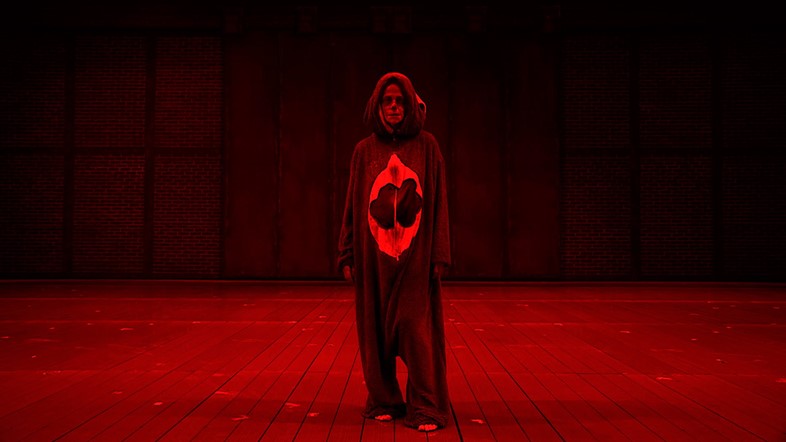We present the brand new trailer for French artist Loris Gréaud's forthcoming film, premiering at LACMA next week, which looks set to break the boundaries of cinema as we know it
Who? French artist Loris Gréaud is a man shrouded in mystery. He refuses to release an artist biography, a fact which, according to his Wikipedia page, means that "most of the biographies available are therefore knowingly incorrect or incomplete". He categorises his work by "projects", choosing to avoid the term "exhibition" and his mission statement, he tells AnOther, is that "the medium [be it film or installation] has to follow the idea".
It may all sound a little overblown, but it does mean that Gréaud's body of work has to speak for itself; and his achievements to date make for an impressive read. He was the first artist to be granted full use of the Palais de Tokyo in Paris for his 2008 project Cellar Door, and the first to be invited to exhibit jointly by the Louvre and the Pompidou Centre (he took over the courtyards of both spaces with an eponymous project in 2013). In 2012, he collaborated with master of surreal cinema David Lynch, hip hop-avantists Anti-pop Consortium and veteran actress Charlotte Rampling for his film project The Snorks: A Concert for Creatures – which Rampling described to us as "an extraordinary project based around animals that live so far underneath the sea that no one has ever seen them and they let out energy through electrics". In 2014, he received a knighthood from the Order of Arts and Letters (Chevalier des Arts et des Lettres).

What? This month marks the unveiling of Gréaud's latest project SCULPT at Los Angeles County Museum of Art (LACMA). Described as "a social science fiction movie", it is Gréaud's first feature-length film and is arguably his most ambitious work to date – it took 30 months to make and has been meticulously readjusted so that its palette matches that of the total lunar eclipse (AKA the "blood moon") of September 2015. And that's just for starters.
"I wanted to produce an object that had lost its centre – an object that would be constantly peripheral, where the film itself wouldn't be the key element but part of a bigger whole," the artist says of his initial idea, dreamt up following lengthy discussions with LACMA's director Michael Govan. "It had to be a story that could turn around you just like you turn around a sculpture."
Gréaud enlisted various collaborators to help bring his concept to life, including Willem Dafoe (the protagonist, who Gréaud says he "always thought and dreamed of for the main character"), Rampling, The Residents (who scored a bespoke soundtrack in what is their first artistic collaboration in 45 years), and perhaps most notably the late, great architect Claude Parent and Voodoo Queen Priestess Miriam Chamani.

"Claude Parent (1923-2016) had always been a great influence before becoming a true mentor to me," Gréaud explains of the former. "I am so grateful to have been able to work and think with such a visionary, elegant and radical artist. I commissioned him to create what we called a 'mental architecture' and asked him to design the description of a structure which one of the actors could visit in his thoughts and dreams." Sadly the architect passed away before his vision was fully realised, but Gréaud was determined to see it through. "When the moment came for the IRM experiment, we were all mourning Claude's recent loss but I decided to do the experiment myself and visit his mental space – it was a true honour."
If this experimentation sounds somewhat cryptic, the contribution of the voodoo queen priestess is even more so: "There is a strange deal with these virgin 16mm rolls that have been cursed or blessed – they are supposed to be filled with spirits. We worked with Mambo Queen Priestess Miriam Chamani in a New Orleans Voodoo temple and performed a real ceremony for the rolls – this is an important sequence of the film. Afterwards, we used those cursed rolls to film some specific scenes... It's part of a whole process, a constant back and forth with fiction and reality."

So what exactly, dare we wonder, is SCULPT about? "The film follows the thoughts of a man about whom we know very little," the dedicated LACMA page informs us, "[and] who seems to be constantly developing the concept of what experiencing beauty, thought, or obsession can be, despite the risks to which the subjects are exposed in the long term."
When it comes to the viewing process itself, it will come as no surprise to learn that each viewer's experience will be highly unique – the museum's Bing Theater has been reconfigured to allow for only one viewer at a time and the film's duration is changeable, ranging between 50 and 125 minutes. The screenings of the film are free and tickets will be released each morning beginning with its premiere on August 16.
Why? It goes without saying that in order to truly understand SCULPT you will have to experience it – like its creator, words simply do not do it justice. But what drives the enigmatic creative to do what he does, and why did he decide to do it? "When I was young and in troubled times, I accidentally saw Stan Brakhage's experimental film, Anticipation of the Night," Gréaud discloses in a rare moment of frankness. "I had never seen or experienced something so strange, something I couldn't understand but that still was communicating with me. It was my first encounter with poetry and I believe since then that I never stopped doing what I'm trying to do."
Loris Gréaud: SCULPT is at LACMA from August 16.